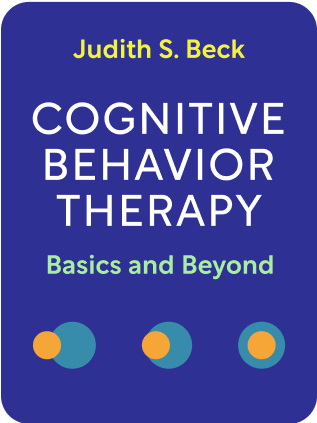

This article is an excerpt from the Shortform book guide to "Cognitive Behavior Therapy: Basics and Beyond" by Judith S. Beck. Shortform has the world's best summaries and analyses of books you should be reading.
Like this article? Sign up for a free trial here .
What are some effective CBT therapy techniques? How can these CBT therapy techniques help you improve your mental health?
Cognitive behavioral therapy is used to treat mental health disorders and challenge negative thinking patterns. Using effective CBT therapy techniques can help you apply the principles of CBT to your own life, improving your mental health.
Find the 27 best CBT therapy techniques below.
CBT Therapy Techniques to Try
CBT is customized to the patient, and different techniques may have different efficacy between patients. Here are some helpful CBT therapy techniques to draw upon:
- Role play an early childhood experience:
- Combat negative core beliefs by role playing an early childhood experience.
- Rationally discuss alternative explanations for the experience.
- For example, say a patient’s mother yelled at her for poor grades, because the mom was embarrassed among her peers.
- The therapist role plays as the younger patient, but mounts a rational resistance against the traumatizer. The patient plays the role of the traumatizer (here, the parent). The roles switch.
- The patient then role plays as an older version of herself sitting beside her younger self. “What does older Annie say to 7-year-old Annie?” “7-year-old Annie, do you believe her?”
- Set positively adjusted core beliefs, rather than extreme positive core beliefs:
- When adjusting and offering alternatives for core beliefs, use positively adjusted ones.
- Turn “I can’t do anything right” into “I can do most things right, and there’s a good reason for when I get something wrong.”
- Do NOT turn it into “I can do everything right.”
- Ask Socratic questions to help gain distance:
- “What is the evidence that your thought is true? What is the evidence on the other side?”
- “What is an alternative way of viewing this situation? What else could explain the person’s behavior/the outcome?”
- “What’s the worst that could happen? How would you cope with this situation?” (You can give solutions to help the thinking.)
- “What’s the best that could happen? What’s the most realistic outcome of this situation?” (This is especially useful if the patient has a catastrophic view.)
- “What is the effect of believing your automatic thought? What could be the effect of changing your thinking?”
- “If your friend were in this situation and had the same automatic thought, what advice would you give him or her?”
- “What should you do going forward? How likely are you to do this?”
- Making decisions: When making decisions and choosing between options, ask the patient to make a list of advantages and disadvantages of each option. Score each entry to help make the ultimate decision.
- Refocusing: when the patient’s attention veers to distracting automatic thoughts, rather than evaluating their automatic thoughts, instead refocus attention on the task at hand.
- Distraction: get the patient’s mind off of automatic thoughts.
- Ask what has worked in the past.
- Suggestions: watch TV, go for a walk, email a friend, clean her desk, or browse the web.
- Exposure: keep engaging the object of concern until the negative affect dissipates.
- Patients often have safety behaviors, such as avoiding thinking about the subject to ward off anxiety, but which perpetuate the fundamental problem.
- Graded task assignments: reaching the ultimate task (such as landing a new job) may be intimidating. Break the task into its constituent stepwise tasks to make each step seem less problematic (for example, prepare the resume, look at job postings, and so on).
- Represent the steps visually with a staircase.
- Role playing
- Assume a positive outcome: “If you knew for sure the teaching assistant would be willing to talk to you, what would you say?”
- Pie technique: visually represent something that causes distress. This can help the patient recognize the reality of a situation.
- Time spent on different activities, with one pie chart showing actual time and another showing ideal time.
- Attribution of causes for a situation. When shown on a pie chart, the most feared cause may be unlikely.
- The likelihood of outcomes. When shown on a pie chart, the catastrophic one may be seen as unlikely.
- Self-comparison: discuss the headwinds the patient has faced by applying them to a different person.
- “We know that depression is a physiological issue. Would you expect someone who was infected with pneumonia to do everything flawlessly?”
- Credit lists
- Keep track of things that were positive or difficult to do.
- This is a good stepping stone to the Core Belief Worksheet.
- Imagery: Often specific vivid images are a primary source of patient distress. Elucidating the image is important for recovery. Synonyms of imagery include mental picture, daydream, fantasy, or memory.
- Continue imagining beyond the image.
- Often the patient stops at the most distressing part. Continuing past the image often shows how the patient will resolve the situation capably.
- Picture what happens in the far future—weeks, months, years after the anxious image. Shows that things will likely be resolved satisfactorily.
- Rework the image to include coping behaviors.
- Ask leading questions to guide the adaptive behaviors that the patient could do in the situation.
- This can include coping behaviors like reading coping cards during the stressful situation.
- Assign homework to remember the positive image.
- Rework the image to imagine a different outcome.
- The outcome could be realistic and imagine likely outcomes. Then talk about behaviors that could push toward this outcome.
- The outcome could also be magical. For example, a scary person could morph into a crying baby with a puff of smoke.
- Imagine the image multiple times in succession. The severity of the image should decrease.
- Use imagery as a therapeutic tool.
- Induce an image of a situation. The patient then rehearses coping techniques.
- Behavioral Experiments
- Negative cognitions are linked to patients’ negative predictions of what will happen. The goal of behavioral experiments is to show that the patient’s negative prediction doesn’t often match the reality of the outcome.
- For example, if a patient is anxious about being socially rejected, a behavioral experiment might consist of calling one of her close friends and reflecting on how the outcome matched her prediction.
- Depressed people often have inactivity as a core problem. They deprive themselves of opportunities for pleasure or mastery, and they engage in dysphoric activities (such as sleeping or lying in bed) that may offer short-term relief from their negative automatic thoughts. Even when they do pleasurable activities, their automatic thoughts may make it displeasurable. (“I’m doing a terrible job. I can’t do this as well as I used to.”) Behavioral experiments try to reverse the vicious cycle and create situations for positive thoughts.
- Use the patient’s daily schedule as an opportunity to spot positive things that the patient isn’t doing, or negative things the patient does too much of. Strive for a good balance between pleasure and mastery.
- Ask how the activities make them feel (probably bad). Then normalize the activity for the patient: “Most depressed people think they’ll feel better in bed. But usually they find that doing anything else is better.”
- Find the easiest behavior:
- Suggest experiments that are within the capability of the patient. Find the version of the behavior that is easiest—finding the right friend to ask out, the easiest physical activity to resume.
- Achieve results within the session:
- If applicable, try to achieve results within the session—collaboratively design experiments that patients can conduct right in the session itself.
- A depressed patient might have the automatic thought, “I won’t be able to concentrate on reading anything.” The experiment could be to read a passage from a book and summarize it for you, to see what degree the thought is valid.
- Positive reinforcement
- Teach the patient to give herself credit when she does a good behavior or detects an automatic thought.
- The patient can tell herself, “Good. I did it.”
- If the patient is skeptical about this, say, “Even if these behaviors used to be easy in the past, being depressed makes it harder. So you deserve credit. When you’re over the depression, you don’t have to give yourself credit.”
- Anticipate barriers to executing the experiment:
- If you sense hesitation from the patient, ask what automatic thought crossed her mind.
- If she doesn’t offer one, say the opposite: “were you thinking about what a good time you’d have?”
- Confront the automatic thought by asking what evidence she has to support it, and what evidence she has to disagree with it.
- Reduce the time delay to conducting the experiment—schedule an action today.
- If the behavior is too imposing, find an easier behavior to start with. Ask what activity takes less energy.
- Preempt negative feelings if the experiment fails: “what would you feel if your friends said no to hanging out?”
- If the patient has no ideas on what’s enjoyable, give a list of 5-10 activities and ask which sound the most enjoyable.
- Use an hourly activity chart to plan out the day.
- Plan in rest sessions.
- The patient should write the activities into the chart herself.
- Rate the sense of mastery and pleasure the person gets.
- Create a scale of 0, 5, and 10 for pleasure and mastery.
- Ask the patient to rate activities the patient has previously done, and to predict her ratings of future activities to come.
- Ideally, the real ratings contradict their predictions. For example, the patient may predict an activity is a 2 in pleasure, then find out later it’s a 6.
- Do a mood check.
- “Tell me in a sentence or two how you felt for most of the week?”
- Ideally the patient fills out a questionnaire beforehand.
- If this is difficult for the patient, simplify the question—”what was your mood, on a scale of 0 to 10?”
- Make broad goals more specific.
- Patient: “I’d like to be happier.”
- Therapist: “If you were happier, what would you be doing?”
- Make the goal something they have control over.
- Less control: “I’d like my boss to stop pressuring me.”
- More control: “Learn new ways of talking to my boss.”
- For depressed patients, try to discuss the problem of inactivity. Overcoming passivity and experiencing pleasure and master is essential. (Shortform note: More generally, find the common problem that, if fixed, will yield short-term results.)
Use the above CBT therapy techniques to understand yourself better and improve your mental well-being.

———End of Preview———
Like what you just read? Read the rest of the world's best book summary and analysis of Judith S. Beck's "Cognitive Behavior Therapy: Basics and Beyond" at Shortform .
Here's what you'll find in our full Cognitive Behavior Therapy: Basics and Beyond summary :
- How to use CBT to overcome anxiety, sadness, anger, frustration, and stress
- How to address traumatic events earlier in your life, so that they have less hold on your thinking today
- The key ways to build rapport as a cognitive behavior therapist






